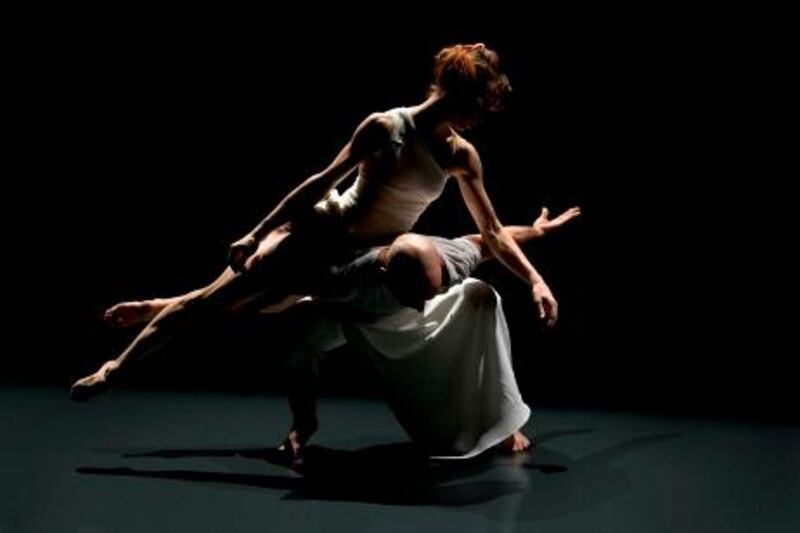Ballet is one of those art forms that divides opinion sharply, even among people who generally love high culture. For some, it's the most beautiful expression of human grace ever created, while for others it's an outdated curiosity with one graceful foot stuck forever in the past.
Where do you stand between these two schools of thought? If you're not sure, you'll have a chance to make up your mind at this year's Abu Dhabi Festival, which hosts two remarkable - and remarkably different - dance performances. Making the case for classical ballet is a gala performed by dancers from the Bolshoi, Mariinksy and American Ballet Theatres on April 1, staging some of the best-loved dances from ballets including Swan Lake and Sleeping Beauty. On a radically different note, the dancers Sylvie Guillem and Russell Maliphant will perform PUSH tonight, a critically raved-about piece of more intuitive, raw contemporary dance.
Despite common ground between the two shows (all performers have training in classical ballet) there is a clash at work here. Guillem may herself have been a great ballerina in her earlier career, but she has lampooned classical ballet's strictly codified arm movements as making dancers look like they are "calling every taxi, doing gestures that have no meaning anymore".
Contemporary dance, meanwhile, is sometimes criticised by lovers of classical ballet as being clumsy and random, without necessarily being any freer of clichés than its predecessors. If you haven't seen much staged dance before, such differences may be hard to visualise - so what can dance novices expect from these two different approaches?
The dancers of the Bolshoi and Mariinsky (formerly Kirov) certainly come closest to the popular image of ballet, with phalanxes of tutu-wearing dancers, lithe, weightless-looking soloists and accompaniment of western classical music. They arguably have more right than anyone else to preserve this style - both companies, after all, have throughout their history played a major role in developing and perfecting it. Matching athleticism with delicacy, their core repertoire stems from ballet's heyday - which, despite being yoked to the term classical, wasn't actually very long ago.
While large-scale narrative dances have been around since the Renaissance, it was in the late 19th century that what we recognise today as classical ballet became crystallised, with works such as those of the Franco-Russian choreographer Marius Petipa elevating the form to a new seriousness. These dazzling, expressive dances pushed performers beyond the limit of what had previously been thought technically possible, and redressed an earlier balance that sidelined male dancers in favour of ballerinas. With its turned-out legs, flying leaps, dizzying turns, and constant elongation of the body through dancing en pointe, the style perfected by Petipa strives to give a sense of elegant weightlessness, as if the dancer is partly floating above the stage.
Needless to say, nothing could be further from the truth. Through intense training of the muscles from the ankle right up to the abdomen, ballet dancers learn how to support and stretch their bodies, all the while using their arms to counterbalance any movements that display the impact of the body's weight on the floor. To develop these skills, and to learn to dance en pointe in hardened slippers without damaging bones, takes years of hard graft that often end in only limited or brief success. Almost all ballet dancers begin training in childhood and only a few with the ideal body shape, stamina and skill manage to become principal dancers.
Once perfected, however, these techniques can give dancers a sense of spirited near-effortlessness, with just enough of a reminder of the steps' difficulty to take your breath away with the dancer's skill.
A truly brilliant dancer, however, will not just offer technical perfection but use steps and gestures to imply a character's emotions. In the famous Black Swan Coda from Swan Lake (included in the Bolshoi Gala), for example, the dancer playing Odile performs a staggering 32 simultaneous fouettés en tournant, ballet-speak for 365 degree turns that are each punctuated with a kick. While famous for its difficulty - the trick is supposedly to whip the head around as quickly as possible while staring at a fixed point. This isn't a feat of athleticism and balance alone. It expresses the character of Odile's malign joy at having managed to trick the male lead into believing that she is the one he loves, when she has in fact only been disguised as such through magic. When performed by a great dancer, the dance glitters with a fierce energy that undercuts the charm of the jewelled costumes and Tchaikovsky's ravishing music with something darker.
It's wonderful that such a rigorous, expressive form continues today - the danger when anything begins to be deemed "classical", however, is that it becomes fixed in a particular period, resistant to change or development. By the beginning of the 20th century, progressive dancers were starting to see ballet's rigid set of steps, its focus on technical brilliance and its rather sugary presentation of the feminine as an expressive straitjacket.
Innovators such as Isadora Duncan and (some years later) Martha Graham developed dances that valued self-expression over technique, creating a wider, more intuitive set of steps developed for each new piece. While these modern dances still required great skill, they moved beyond classical ballet's concern with masking the effects of gravity to create a more obviously muscular, floor-based approach that acknowledged the weight of the dancer's body.
It is as a continuation of this anti-tradition that the four dances that make up Guillem and Maliphant's PUSH should be read. Granted, both dancers have had their technique - their very bodies - moulded by classical training, as Maliphant trained at London's Royal Ballet School while Guillem, formerly the principal dancer at the Paris Opera Ballet, received the first Nijinsky Award for the world's best ballet dancer. Despite this classical grounding, the pair's influences are eclectic, drawing on practices as varied as martial arts, gymnastics and tango. While this eclecticism might be jarring, the seamless elegance of the dancers' movements integrates everything to create a feeling of moonlit sensuousness and connection that makes their dancing seem organic and instinctive. The pair also show a remarkable flair for understatement. In Guillem's solo dance Two for example, she spends much time with her limbs just tentatively feeling out the limits of a narrow light box in the centre of a darkened stage. Against a minimal electronic soundtrack that grows to a throb, Guillem's body steadily begins to swoop and rotate to fill the space, as if defending it from an unseen opponent with some especially sinuous form of Kung Fu.
This all seems a long way from classical ballet - but then it's unlikely that Guillem would be able to perform these forceful movements with such consistent, apparently unconscious grace without her long grounding in more traditional dance. Ballet may have been around a long time, but its rigorous approach and moulding of the body clearly still shape the dances of performers feeling around, as in Guillem's dance, in search of something else.
- PUSH is performed tonight at the Emirates Palace, and the ballet gala on April 1.
Follow us on twitter and keep up to date with the latest in arts and lifestyle news at twitter.com/LifeNationalUAE





